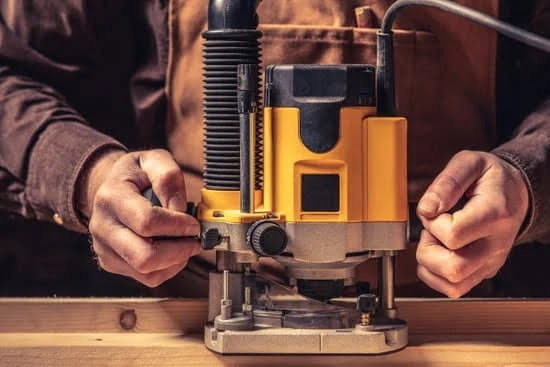Woodworking is a timeless craft that requires not only skill and creativity, but also the right set of tools. Whether you are a beginner or an experienced woodworker, understanding and utilizing the appropriate tools can make all the difference in your craftsmanship. In this article, we will explore the fascinating world of woodworking tools, providing insight into their importance and practical applications.
From essential hand tools to power tools that enhance efficiency, measuring and marking tools for accuracy, joining and fastening tools for sturdiness, woodcarving and shaping tools for creativity, finishing tools for smooth results, to safety gear and essential accessories – we will cover a comprehensive list of woodworking tools. Each tool serves a specific purpose in the woodworking process, ultimately contributing to the overall quality and success of your projects.
By equipping yourself with the knowledge of these various woodworking tools, you can unlock your full potential as a woodworker. Whether you aspire to build furniture pieces, create intricate designs through carving, or simply expand your DIY skills – having a deep understanding of these indispensable instruments will undoubtedly elevate your craftsmanship. So let’s dive into the diverse array of woodworking tools and discover how they can help bring your woodworking visions to life.
Essential Hand Tools for Woodworking
Woodworking is an art that requires the right tools to achieve precision and high-quality results. While power tools have become increasingly popular, essential hand tools still play a crucial role in woodworking. These foundational tools are a must-have for any woodworker’s toolbox, providing versatility and control in shaping, cutting, and finishing wood.
Chisels: Chisels are indispensable hand tools for woodworking. They come in various sizes to accommodate different tasks. A sharp chisel can be used for creating clean and precise cuts on both soft and hard woods. Chisels are commonly used for tasks such as removing waste material, carving intricate designs, or creating joinery.
Hand Planes: Hand planes are versatile tools used for smoothing surfaces or shaping wood by removing thin shavings. They consist of a cutting blade mounted on a flat base that allows the user to precisely adjust the depth of cut. Hand planes are particularly useful when working with uneven or rough stock, helping to create flat and smooth surfaces.
Coping Saws: Coping saws are small handheld saws with narrow blades that excel at making curved cuts in wood. They are invaluable when it comes to intricate work such as cutting out patterns or trimming moldings. Coping saws allow for greater maneuverability compared to larger saws and provide more control when navigating complex curves.
Investing in these essential hand tools will not only enhance your woodworking skills but also give you a deeper understanding of the craft. Learning how to use these tools effectively will enable you to tackle an array of woodworking projects with confidence and precision.
- Chisels: Used for carving intricate designs and creating joinery.
- Hand Planes: Versatile tools for smoothing surfaces and shaping wood.
- Coping Saws: Ideal for making curved cuts, patterns, and trimmings.
Whether you are a beginner or experienced woodworker, having these essential hand tools in your arsenal is fundamental for achieving professional results. They offer a level of control and craftsmanship that power tools cannot replicate. So, take the time to familiarize yourself with these indispensable hand tools and embrace the art of woodworking at its finest.
Power Tools for Efficient Woodworking
Woodworking has come a long way from relying solely on hand tools. Power tools have revolutionized the field by providing woodworkers with enhanced precision and efficiency. Whether you’re a beginner or an experienced woodworker, having the right power tools in your workshop can make a significant difference in the quality of your projects. In this section, we will explore the wide range of power tools that are essential for efficient woodworking.
- Table Saws: The workhorse of any woodworking shop, a table saw is a versatile tool that allows for precise and repetitive cuts. Its flat surface and adjustable fence provide stability and accuracy when cutting through various types of wood. Whether you need to rip boards or create complex joinery, a table saw is an invaluable tool to have.
- Mitre Saws: For making accurate crosscuts and mitre angles, a mitre saw is essential. This power tool features a rotating circular blade mounted on a hinged arm, allowing for consistent angle cuts to be made. It’s particularly useful when creating frames, trim work, or any project that requires precise angled cuts.
- Routers: Routers are incredibly versatile power tools that offer endless possibilities for shaping edges, creating intricate designs, and even cutting precise joinery. With different bits available for various purposes like chamfering edges or creating decorative patterns, routers allow woodworkers to add unique details to their projects effortlessly.
- Bandsaws: Bandsaws are excellent tools for cutting irregular shapes or curves in wood. Using a continuous band of toothed metal driven by two wheels, bandsaws offer more flexibility compared to other cutting tools. From resawing large pieces of timber to crafting delicate scrollwork, bandsaws are indispensable in any woodworking shop.
When investing in power tools for woodworking, it’s crucial to prioritize safety as well as functionality. Always wear appropriate safety gear such as safety goggles and ear protection when operating these powerful machines. Furthermore, make sure to follow manufacturer guidelines and take the time to learn how to use each tool correctly.
By equipping your workshop with these power tools, you’ll unlock a whole new level of efficiency and precision in your woodworking projects. Whether you’re building furniture, crafting intricate wooden designs or working on small DIY projects, having the right power tools will help you achieve professional-looking results in less time.
Measuring and Marking Tools for Accuracy
Accurate measuring and marking is crucial in woodworking to ensure precise cuts and proper fitment of wood pieces. Without the right tools, it can be challenging to achieve professional-level results. In this section, we will discuss the importance of accurate measuring and marking in woodworking and highlight some essential tools every woodworker should have in their toolbox.
- Tape Measures: A tape measure is a must-have tool for any woodworker. It allows you to take precise measurements of different lengths quickly and easily. Look for a tape measure with clear markings and a locking mechanism to keep your measurements secure.
- Combination Squares: Combination squares are versatile tools that are used for both measuring and marking straight lines at 90-degree angles. They typically consist of a ruler, a headstock with a level bubble, and a removable square head. This tool is ideal for checking the squareness of corners or marking cutlines accurately.
- Marking Gauges: Marking gauges are used to scribe lines parallel to an edge or make repeated marks at consistent distances from an edge. These tools ensure accurate positioning when joining or shaping wood pieces together. There are several types of gauges available, including wheel gauges, cutting gauges, and mortise gauges.
To enhance accuracy further, consider adding other measuring tools such as calipers, bevel gauges, or digital angle finders to your collection. Building up your arsenal of measuring and marking tools will significantly improve the quality of your woodworking projects.
Remember to always measure twice before making any cuts or adjustments, as accurate measuring plays a vital role in achieving professional-level craftsmanship.
Joining and Fastening Tools for Sturdy Woodwork
When it comes to creating sturdy and reliable woodwork, having the right joining and fastening tools is crucial. These tools not only help secure wood pieces together but also ensure that the structure remains strong over time. In this section, we will explore some of the essential joining and fastening tools that every woodworker should have in their arsenal.
One indispensable tool for joining wood is a clamp. Clamps come in various shapes and sizes, such as bar clamps, pipe clamps, and spring clamps. They are used to hold pieces of wood firmly together while glue dries or when joining them permanently using screws or nails. Clamps provide even pressure distribution, preventing any gaps or movement between the wood pieces during assembly.
Another common tool used for fastening wood is a nail gun. Nail guns are powered by compressed air or gas and make attaching nails quick and efficient. With a nail gun, you can drive nails into the wood effortlessly and precisely, saving time compared to manually hammering each nail. Nail guns are especially useful when working on larger projects that require multiple nails for secure fastening.
Lastly, let’s talk about pocket-hole jigs. A pocket-hole jig allows you to create pocket holes, which are angled holes drilled into one piece of wood that can be joined to another with screws. This method provides strong connections without the need for visible screws on the surface of your project. Pocket-hole jigs are particularly useful when building cabinets, furniture frames, or any project where hidden joints are desired.
| Tool | Benefits |
|---|---|
| Clamp | – Provides even pressure distribution during assembly
|
| Nail Gun | – Saves time and effort compared to manual hammering
|
| Pocket-Hole Jig | – Allows for hidden joints without visible screws
|
By having these joining and fastening tools in your workshop, you can ensure that your woodworking projects are not only beautiful but also structurally sound. Whether you are a beginner or a seasoned woodworker, investing in these essential tools will help you achieve sturdy and reliable woodwork that will stand the test of time.
Woodcarving and Shaping Tools for Creativity
Woodcarving and shaping tools are essential for woodworkers who want to add intricate details and artistic designs to their projects. These tools allow craftsmen to unleash their creativity and create unique and personalized pieces of woodworking art. Woodcarving and shaping tools come in a variety of forms, each serving a specific purpose.
One of the most versatile tools for woodcarving is the carving chisel. With its sharp, pointed blade, it allows woodworkers to remove small or large amounts of material, depending on the desired design. Carving chisels come in different shapes and sizes, allowing for the creation of various patterns and textures.
Another tool that is commonly used in wood shaping is the spokeshave. This tool consists of a small curved blade held by two handles, resembling a plane. The spokeshave is ideal for shaping curved surfaces, creating concave or convex shapes with precision and control.
For more detailed work, woodworkers often turn to rasps. Rasps are coarse files with sharp teeth that can quickly remove material from surfaces. They are particularly useful for rounding corners or smoothing rough edges.
These woodcarving and shaping tools provide endless opportunities for expressing creativity and adding unique touches to woodworking projects. Whether it’s carving intricate patterns onto furniture pieces or shaping wooden sculptures, these tools open up a whole new world of possibilities for woodworkers.
By investing in quality woodcarving and shaping tools, craftsmen can expand their skill set and elevate their woodworking projects to new heights of artistry. With practice and experimentation, these tools will become invaluable assets in the pursuit of turning blocks of wood into works of art. So embrace your creative side, explore the many facets of woodcarving and shaping tools, and let your imagination soar as you bring your woodworking projects to life with added flair.
Finishing Tools to Achieve Beautiful Results
When it comes to woodworking, the process doesn’t end with the construction of a project. Finishing touches are what truly transform a piece of woodwork into a polished and beautiful result. To achieve professional-looking results, woodworkers rely on a variety of finishing tools.
These tools are designed to refine surfaces, remove imperfections, and create smooth finishes that enhance the natural beauty of the wood. In this section, we will explore some essential finishing tools that every woodworker should have in their arsenal.
Sandpaper
One of the most basic yet indispensable finishing tools is sandpaper. Sanding is an important step in achieving a smooth surface before applying any finish. Sandpaper comes in different grit sizes, ranging from coarse to fine. Coarse-grit sandpapers are used for initial shaping and removing large imperfections, while finer grits gradually smooth out the surface for a polished finish. It’s important to progress through different grit levels to achieve desired results without scratching or damaging the wood.
Scrapers
Another tool commonly used for refining wood surfaces is scrapers. These handheld tools have sharp edges that scrape off thin layers of wood to flatten and smoothen uneven areas. Scrapers can be especially useful for removing dried glue residue, smoothing out rough patches, or removing paint or old finishes. They provide precise control and allow woodworkers to achieve consistent smoothness across surfaces.
Brushes
Applying finishes such as varnishes, stains, or paints requires suitable brushes that ensure even application and smooth coverage. Quality brushes made specifically for woodworking prevent streaks and brush marks so that finishes can be seamlessly blended into the wood. Depending on the type of finish being applied and the desired effect, different types and sizes of brushes may be needed.
Whether you’re working on a simple cutting board or an intricate piece of furniture, the right finishing tools can make all the difference in the final outcome. Sandpapers, scrapers, and brushes are just a few examples of essential finishing tools that woodworkers rely on to achieve beautiful results.
Mastering the use of these tools will not only enhance the appearance of your woodworking projects but also give you a sense of pride and satisfaction in your craftsmanship. So, be sure to invest in quality finishing tools and take your woodworking skills to the next level.
Safety Gear and Essential Accessories for Woodworking
When engaging in woodworking projects, it is crucial to prioritize safety and comfort. This section highlights the importance of safety gear and essential accessories in ensuring a safe and enjoyable woodworking experience. By investing in the right equipment, woodworkers can protect themselves from potential hazards and optimize their performance.
One of the most fundamental pieces of safety gear for woodworking is protective eyewear. Safety goggles or glasses shield the eyes from flying debris, dust particles, and harmful chemicals. Additionally, ear protection such as earmuffs or earplugs should be worn to minimize exposure to loud noise generated by power tools.
Another indispensable accessory for a comfortable woodworking experience is a dust collection system. Sawdust can pose health risks if inhaled over an extended period. A dust collector helps remove airborne particles from the workspace, preserving air quality and reducing the risk of respiratory issues.
Furthermore, having proper ventilation in the workshop is essential to ensure adequate fresh airflow. This prevents dust buildup, fumes from finishing materials, or noxious odors from becoming concentrated in the workspace.
In addition to safety gear and ventilation systems, there are other accessories that can greatly enhance a woodworker’s efficiency and precision. Workbench clamps are a versatile tool that secures workpieces firmly in place during cutting, shaping, or joining processes. These clamps provide stability and prevent slipping or movement while working with power tools.
It is also advantageous to invest in various jigs and guides that support accurate cuts and measurements. For instance, featherboards can be attached to table saws or band saws to guide workpieces steadily along a desired cutting path.
| Safety Gear | Essential Accessories |
|---|---|
| Safety goggles or glasses | Workbench clamps |
| Ear protection (earmuffs or earplugs) | Dust collection system |
| Dust mask or respirator | Featherboards |
| Gloves for hand protection | Bench dogs for securing workpieces to a benchtop |
By equipping themselves with proper safety gear and essential accessories, woodworkers can create a safer and more productive environment. These tools not only protect against potential hazards but also enhance precision, stability, and overall woodworking capabilities. Remember, investing in these items is an investment in both the quality of your work and your own well-being.
Conclusion
In conclusion, the world of woodworking tools is vast and fascinating, offering endless possibilities for creativity and craftsmanship. Throughout this article, we have explored essential hand tools, power tools, measuring and marking tools, joining and fastening tools, woodcarving and shaping tools, finishing tools, as well as safety gear and accessories. Learning about these different types of tools is crucial for any woodworking enthusiast looking to unlock their full potential.
By having a solid foundation of essential hand tools such as chisels, hand planes, and coping saws, woodworkers can tackle a variety of projects with precision and finesse. Additionally, power tools like table saws, mitre saws, and routers provide efficiency and accuracy in cutting materials. Measuring accurately with tape measures or combination squares ensures that every piece fits together seamlessly.
Furthermore, it is important to understand that joining and fastening play a crucial role in creating sturdy woodwork. Tools like clamps, nail guns, and pocket-hole jigs enable the secure connection of wood pieces for enhanced durability. For those who enjoy adding intricate details to their projects through carving or shaping wood pieces require specific tools such as carving chisels or spokeshaves. And once the project is complete, using finishing tools like sandpaper or scrapers ensures a smooth surface.
In the end, investing in proper safety gear cannot be emphasized enough when working with these powerful woodworking tools. Goggles protect your eyes from flying debris while ear protection safeguards your hearing from loud machinery. Dust collection systems are also vital for maintaining a clean work environment.
To unlock your woodworking potential, it is essential to equip yourself with the right set of tools that suit your interests and projects. By understanding the benefits and applications of each tool discussed in this article, you can enhance your skills as a woodworker and embark on fulfilling projects. So go ahead and start building your toolbox today – the possibilities are endless.
Frequently Asked Questions
What tools do you use in woodwork?
In woodworking, there is a wide range of tools that can be used depending on the specific project and desired outcome. Some commonly used tools include a saw, chisel, plane, hammer, mallet, sandpaper, drill, router, tape measure, and clamps.
These tools are essential for tasks such as cutting wood to size, shaping and smoothing surfaces, joining pieces together, creating holes or openings, and ensuring accuracy in measurements and alignments. Additionally, advanced woodworking may involve the use of specialized tools like a bandsaw, lathe, jointer, planer, or various power tools.
What is the basic tool in woodworking?
The basic tool in woodworking is arguably the hand-held saw. A saw allows woodworkers to cut through wood along different angles and shapes to achieve the desired dimensions or sections required for their projects.
Common types of saws used in woodworking include crosscut saws for making straight cuts across the grain of wood fibers and rip saws for cutting along the grain to remove excess material. While there are many other tools involved in woodworking that contribute to more intricate processes and details, the basic hand-held saw remains an essential tool for most woodworking projects.
What do you need to learn in woodworking?
To become proficient in woodworking-with-hand-tools/” target=”_blank” rel=”follow noopener”>woodworking requires a foundation of knowledge about different wood types, their characteristics and best uses; understanding how to read and interpret project plans or blueprints; learning various joinery techniques like dovetail joints or mortise-and-tenon joints; gaining proficiency with measuring and marking tools to ensure precision; mastering proper techniques for using different tools safely; understanding finishes and how they interact with different woods; honing problem-solving skills when obstacles arise during a project; developing an eye for design aesthetics; appreciating the importance of patience and attention to detail in achieving quality craftsmanship.
Learning from experienced woodworkers through apprenticeships or joining communities of enthusiasts can greatly enhance one’s knowledge and skills in this craft.field.Tool escalation

Hi everyone! I’m a woodworker and blogger, and this is my woodworking blog. In my blog, I share tips and tricks for woodworkers of all skill levels, as well as project ideas that you can try yourself.





